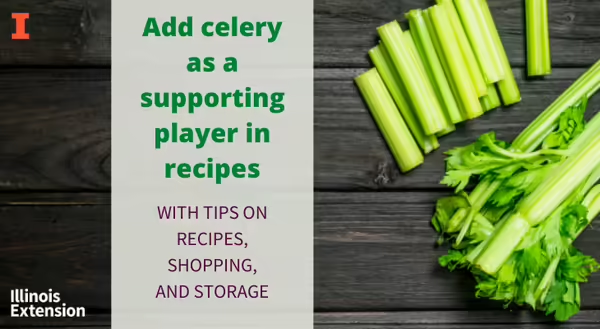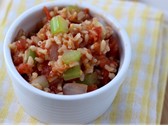
I'm ready for some green this spring! While you have lots of options with spring flowers and impending green blades of grass, let's talk about the humble celery. And we can celebrate that March is National Celery Month.
Nutritionally, a large stalk of celery contains 10 calories, 2g carbohydrate, 1g fiber, and vitamins and minerals, including vitamin A and a number of B vitamins, potassium, phosphorus, and magnesium. Like many vegetables, celery is not a significant source of sodium, fat, or protein.
- Buy: Look for fresh heads of celery that are deep green in color. Stalks should be firm, and any attached leaves should be full, without signs of wilting. Avoid stalks that are limp or showing signs of damage. If your store sells pre-cut celery, look for signs that the celery is still firm and not turning yellow or white. Celery may also be pre-cut in the freezer case, either alone or with other vegetables, which makes a great convenience food.
- Price: According to the U.S. Department of Agriculture, fresh celery costs $1.09 per pound on average. Pound for pound, pre-cut celery will typically cost more than whole heads.
- Store: Celery keeps good quality in the crisper drawer of your refrigerator. With its high water content, celery loses moisture quickly, so it will keep for 1 week, maybe a week and a half. Rehydrate limp celery by cutting a small section off the bottom of the stalk and soaking in water.
- Preserve: Freezing celery at home is an option for preserving. Since freezing breaks cell walls of plants, the frozen celery will be best in cooked recipes. There are no tested recipes for canning celery on its own, there are some recipes using celery as an ingredient, such as Tomato and Vegetable Juice Blend, Pickled Three-Bean Salad, and Barbecue Sauce.
- Prepare: From a whole head of celery, pull off as many stalks as needed. Wash and cut into desired size pieces. The leaves are edible, or remove them if you prefer.
- Eat: I called celery "humble" earlier because it rarely is the star of a recipe. Instead, it often plays a supporting role. Raw celery adds crunch. Cooked celery adds a mild flavor.
Animal Crackers on a Log | Print recipe
serves 3
Apple Tuna Salad | Print recipe
serves 6
Cheesy Rice and Tomatoes | Print recipe
serves 6
References:
- University of Nebraska-Lincoln Extension, Nutrition Education Program, Celery, N/D
- Purdue FoodLink, Celery, N/D
- United States Department of Agriculture, FoodData Central
Post originally published in 2015; content updated in 2022.
Healthy Eats and Repeat
How much difference is there between canned and frozen foods? How should you cook venison? When is the best time to buy avocados? Get answers to these questions as well as other tips, tutorials and recipes for common kitchen foods and items with University of Illinois Extension Nutrition & Wellness Educator Caitlin Mellendorf’s blog Healthy Eats and Repeat. Build your best life. Trust Extension to help.
Caitlin Mellendorf is an Illinois Extension Nutrition and Wellness Educator serving DeWitt, Macon and Piatt Counties in Central Illinois. She is a Registered Dietitian and her work focuses on helping community members gain the knowledge, skills and tools to live healthier, more nutritious lifestyles. This includes providing programs and answering questions about heart health, diabetes, food safety, food preservation, grocery shopping and cooking. You can reach Caitlin by email at chuth2@illinois.edu or call 217.877.6042. Check out her nutrition blog Healthy Eats and Repeats for seasonal recipes and of an exploration of common kitchen foods.


